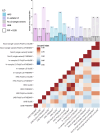This is a preprint.
Fine-mapping genomic loci refines bipolar disorder risk genes
- PMID: 38405768
- PMCID: PMC10889003
- DOI: 10.1101/2024.02.12.24302716
Fine-mapping genomic loci refines bipolar disorder risk genes
Update in
-
Fine-mapping genomic loci refines bipolar disorder risk genes.Nat Neurosci. 2025 Jul;28(7):1393-1403. doi: 10.1038/s41593-025-01998-z. Epub 2025 Jun 25. Nat Neurosci. 2025. PMID: 40562893 Free PMC article.
Abstract
Bipolar disorder (BD) is a heritable mental illness with complex etiology. While the largest published genome-wide association study identified 64 BD risk loci, the causal SNPs and genes within these loci remain unknown. We applied a suite of statistical and functional fine-mapping methods to these loci, and prioritized 17 likely causal SNPs for BD. We mapped these SNPs to genes, and investigated their likely functional consequences by integrating variant annotations, brain cell-type epigenomic annotations, brain quantitative trait loci, and results from rare variant exome sequencing in BD. Convergent lines of evidence supported the roles of genes involved in neurotransmission and neurodevelopment including SCN2A, TRANK1, DCLK3, INSYN2B, SYNE1, THSD7A, CACNA1B, TUBBP5, PLCB3, PRDX5, KCNK4, CRTC3, AP001453.3, TRPT1, FKBP2, DNAJC4, RASGRP1, FURIN, FES, DPH1, GSDMB, MED24 and THRA in BD. These represent promising candidates for functional experiments to understand biological mechanisms and therapeutic potential. Additionally, we demonstrated that fine-mapping effect sizes can improve performance of BD polygenic risk scores across diverse populations, and present a high-throughput fine-mapping pipeline (https://github.com/mkoromina/SAFFARI).
Conflict of interest statement
Competing interests OAA has served as a speaker for Janssen, Lundbeck, and Sunovion and as a consultant for Cortechs.ai. SKS has served as speaker for Janssen, Takeda and Medice Arzneimittel Puetter GmbH & CoKG. EV has received grants and served as consultant, advisor or CME speaker for the following entities (unrelated to the present work): AB-Biotics, Abbott, Abbvie, Adamed, Angelini, Biogen, Biohaven, Boehringer Ingelheim, Casen-Recordati, Celon, Compass, Dainippon Sumitomo Pharma, Ethypharm, Ferrer, Gedeon Richter, GH Research, Glaxo Smith-Kline, Idorsia, Janssen, Johnson & Johnson, Lundbeck, Newron, Novartis, Organon, Otsuka, Rovi, Sage, Sanofi-Aventis, Sunovion, Takeda, and Viatris. PBM has received remuneration from Janssen (Australia) and Sanofi (Hangzhou) for lectures, and Janssen (Australia) for advisory board membership. MOD and MJO have received grants from Akrivia Health and Takeda Pharmaceuticals for work unrelated to this project.
Figures





References
-
- Craddock N. & Sklar P. Genetics of bipolar disorder. Lancet 381, 1654–1662 (2013). - PubMed
-
- McGuffin P. et al. The heritability of bipolar affective disorder and the genetic relationship to unipolar depression. Arch. Gen. Psychiatry 60, 497–502 (2003). - PubMed
-
- Smoller J. W. & Finn C. T. Family, twin, and adoption studies of bipolar disorder. Am. J. Med. Genet. C Semin. Med. Genet. 123C, 48–58 (2003). - PubMed
Publication types
Grants and funding
LinkOut - more resources
Full Text Sources
Miscellaneous
